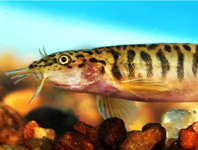Abstract
A new species of hill-stream loach, Indoreonectes telanganaensis, is described from a seasonal tributary of the Godavari River at Maisamma Loddi, within the Kawal Tiger Reserve, Telangana State, India. The new species is distinguished from its congeners by a combination of characters including caudal peduncle as long as deep; eye large, its diameter about one-fifth head length; pectoral fin as long as head; nasal barbel reaching the middle of the eye; dorsal-fin origin on vertical through pelvic-fin origin; and bars on the lateral side of the body well defined and wide. We also provide multivariate morphometric, and DNA analysis based on the mitochondrial cytochrome b gene sequence to support the distinction of the new species.
References
Altschul, S.F., Gish, W., Miller, W., Myers, E.W. & Lipman, D.J. (1990) Basic local alignment search tool. Journal of Molecular Biology, 215, 403–410.
https://doi.org/10.1016/S0022-2836(05)80360-2
Anderson, M.J. (2001) A new method for non-parametric multivariate analysis of variance. Austral Ecology, 26, 32–46.
https://doi.org/10.1111/j.1442-9993.2001.01070.pp.x
Bănărescu, P. & Nalbant, T.T. (1995) A generical classification of Nemacheilinae with description of two new genera (Teleostei: Cypriniformes: Cobitidae). Travaux du Muséum d’Histoire Naturelle “Grigore Antipa, 35, 429–496.
Bohlen, J., Dvořák, T., Šlechta, V. & Šlechtová, V. (2020) Resolving an unnoticed diversity within the Schistura robertsi species complex (Teleostei: Nemacheilidae) using molecules and morphology. Molecular Phylogenetics and Evolution, 151, 106894.
https://doi.org/10.1016/j.ympev.2020.106894
Chopra, B. (1946) Zoological Survey of India, 1942–1945. Records of the Indian Museum, 44, 347–355.
Dahanukar, N., Raut, R. & Bhat, A. (2004) Distribution, endemism and threat status of freshwater fishes in the Western Ghats of India. Journal of Biogeography, 31, 123–136.
https://doi.org/10.1046/j.0305-0270.2003.01016.x
Day, F. (1872) Monograph of Indian Cyprinidae. Part 2. Journal of the Asiatic Society of Bengal, 41, 171–198.
Day, F. (1878) s.n. The fishes of India; being a natural history of the fishes known to inhabit the seas and fresh waters of India, Burma, and Ceylon, Part 4, pp. i–xx + 553–778, pls. 139–195.
https://doi.org/10.5962/bhl.title.55567
Edgar, R.C. (2004) MUSCLE: multiple sequence alignment with high accuracy and high throughput. Nucleic Acids Research, 32, 1792–1797.
https://doi.org/10.1093/nar/gkh340
Hammer, Ø., Harper, D.A.T. & Ryan, P.D. (2001) PAST: Paleontological statistics software package for education and data analysis. Palaeontologia Electronica, 4, 1–9.
Kazi, A., Patel, H., Naik, V. & Tank, S.K. (2018) First record of two species of stone loaches (Teleostei: Nemacheilidae) from Gujarat, India. NeBIO, 9, 36–38.
Keskar, A., Kumkar, P., Katwate, U., Ali, A., Raghavan, R. & Dahanukar, N. (2015) Redescription of Nemachilichthys rueppelli, a senior synonym of N. shimogensis (Teleostei: Nemacheilidae). Zootaxa, 4059 (3), 555–568.
https://doi.org/10.11646/zootaxa.4059.3.7
Keskar, A., Raghavan, R., Paingankar, M.S., Kumkar, P., Katwate, U., Jadhav, S., Padhye, A. & Dahanukar, N. (2018) Molecular phylogeny unveils hidden diversity of hillstream loaches (Cypriniformes: Cobitoidea) in the northern Western Ghats of India. Meta Gene, 17, 237–248.
https://doi.org/10.1016/j.mgene.2018.07.002
Kottelat, M. (1987) Nomenclatural status of the fish names created by J. C. van Hasselt (1823) and of some cobitoid genera. Japanese Journal of Ichthyology, 33, 368–375.
https://doi.org/10.1007/BF02904097
Kottelat, M. (1990) New species and populations of cave nemacheilines in south and south-east Asia (Osteichthyes: Balitoridae). Mémoires de Biospéologie, 17, 49–55.
Kottelat, M. (2012) Conspectus Cobitidum: an inventory of the loaches of the world (Teleostei: Cypriniformes: Cobitoidei). Raffles Bulletin of Zoology, Supplement No. 26, 1–199.
Kumar, S., Stecher, G. & Tamura, K. (2016) MEGA7: Molecular Evolutionary Genetics Analysis version 7.0 for bigger datasets. Molecular Biology and Evolution, 33, 1870–1874.
https://doi.org/10.1093/molbev/msw054
Lanfear, R., Calcott, B., Ho, S.Y. & Guindon, S. (2012) PartitionFinder: combined selection of partitioning schemes and substitution models for phylogenetic analyses. Molecular Biology and Evolution, 29, 1695–1701.
https://doi.org/10.1093/molbev/mss020
Menon, A.G.K. (1987) The fauna of India and the adjacent countries. Pisces. Vol. IV. Teleostei—Cobitoidea. Part 1. Homalopteridae. Zoological Survey of India, Calcutta, x + 259 pp., pls. 1–16.
Minh, B.Q., Nguyen, M.A.T. & von Haeseler, A. (2013) Ultrafast approximation for phylogenetic bootstrap. Molecular Biology and Evolution, 30, 1188–1195.
https://doi.org/10.1093/molbev/mst024
Nei, M. & Kumar, S. (2000) Molecular Evolution and Phylogenetics. Oxford University Press, Oxford, xiv + 333 pp.
Nguyen, L.T., Schmidt, H.A., von Haeseler, A. & Minh, B.Q. (2015) IQ-TREE: a fast and effective stochastic algorithm for estimating maximum likelihood phylogenies. Molecular Biology and Evolution, 32, 268–274.
https://doi.org/10.1093/molbev/msu300
Perdices, A., Ozeren, C.S., Erkakan, F. & Freyhof, J. (2018) Diversity of spined loaches from Asia Minor in a phylogenetic context (Teleostei: Cobitidae). PLoS One, 13, e0205678.
https://doi.org/10.1371/journal.pone.0205678
Prokofiev, A.M. (2010) Morphological classification of loaches (Nemacheilinae). Journal of Ichthyology, 50, 827–913.
https://doi.org/10.1134/S0032945210100012
Raghavan, R. & Ali, A. (2011). Nemacheilus keralensis. The IUCN Red List of Threatened Species, 2011, e.T172477A6900154. Available from: https://doi.org/10.2305/IUCN.UK.2011-1.RLTS.T172477A6900154.en (accessed 25 August 2020)
Rambaut, A. (2009). FigTree. Version 1.4.3. Available from http://tree.bio.ed.ac.uk/software/figtree (accessed 25 September 2017)
Rema Devi, K., Indra, T.J. & Krishnan, S. (2002) On the distribution of Oreonectes (Indoreonectes) evezardi Day and O. keralensis Rita, Banerescu and Nalbant (Pisces: Balitoridae). Journal of the Bombay Natural History Society of India, 99, 127–129.
Rema Devi, K., Indra, T.J., Yadav, B.E., Raghunathan, M.B., Krishnan, S. & Jadhav, S.S. (2013) Freshwater fishes. Zoological Survey of India, Fauna of Karnataka, State Fauna Series, 21, 239–276.
Rita, S.D., Banarescu, P.M. & Nalbant, T.T. (1978) Oreonectes (Indoreonectes) keralensis a new subgenus and species of loach from Kerala, India (Pisces, Cobitidae). Travaux du Museum National d’Histoire Naturelle “Grigore Antipa”, 19, 185–188.
Schwarz, G. (1978) Estimating the dimension of a model. Annals of Statistics, 6, 461–464.
https://doi.org/10.1214/aos/1176344136
Tang, Q., Liu, H., Mayden, R. & Xiong, B. (2006) Comparison of evolutionary rates in the mitochondrial DNA cytochrome b gene and control region and their implications for phylogeny of the Cobitoidea (Teleostei: Cypriniformes). Molecular Phylogenetics and Evolution, 39, 347–357.
https://doi.org/10.1016/j.ympev.2005.08.007
Whitehead, P.J.P. & Talwar, P.K. (1976) Francis Day (1829–1889) and his collections of Indian fishes. Bulletin of the British Museum (Natural History), Historical Series, 5, 1–189.
Xiao, W., Zhang, Y. & Liu, H. (2001) Molecular systematics of Xenocyprinae (Teleostei: Cyprinidae): taxonomy, biogeography, and coevolution of a special group restricted in East Asia. Molecular Phylogenetics and Evolution, 18, 163–173.


